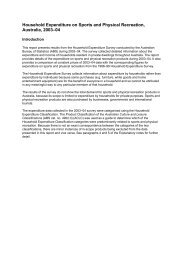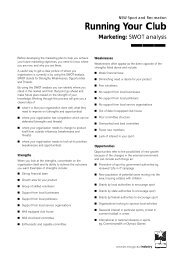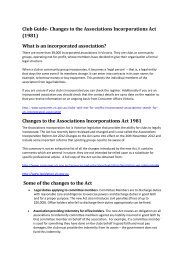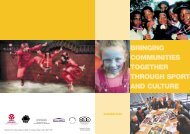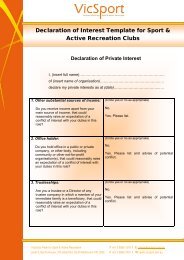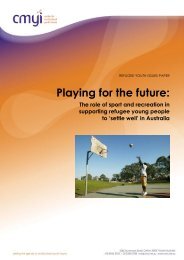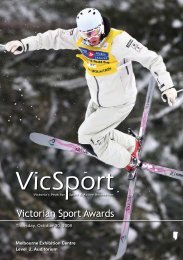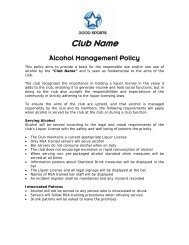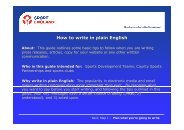School Playing Fields: Planning and Design Guidance - VicSport
School Playing Fields: Planning and Design Guidance - VicSport
School Playing Fields: Planning and Design Guidance - VicSport
You also want an ePaper? Increase the reach of your titles
YUMPU automatically turns print PDFs into web optimized ePapers that Google loves.
Figure 12: Pitch orientation in relation to aspect.285ºW235º225ºBest commonorientation325º345ºSports pitches200ºReciprocal bearings areshown with a dashed lineNPractical limits for preferreddirection of play for all facilitiesHardcourts<strong>and</strong>Grass360ºnetballStenniscourtstennisReciprocalbearings below165ºOrientationThe alignment of pitches <strong>and</strong> courts in relationto the sun should be considered. Given the longhours of use which school playing fields mightexperience it is not possible to alleviate allproblems of glare but proper orientation can helpto minimise them. Problems are caused not onlyby the early morning <strong>and</strong> evening sun but also bythe low angle of the winter sun throughout muchof the day. A playing direction of broadly NNW toSSE is desirable for most games <strong>and</strong> will ensurethat players will face the sun when it is at itshighest <strong>and</strong> least troublesome.20ºSource: National <strong>Playing</strong> <strong>Fields</strong> Association145º45º55ºE105ºPavillion should avoid the SWto NW aspect (225º-315º)In some circumstances, topography or the shapeof a site might prevent the ideal pitch orientationbeing achieved. In such cases, cost issues or theneed to provide a certain number of pitches maytake precedence over achieving the idealorientation in relation to the sun.The National <strong>Playing</strong> <strong>Fields</strong> Association (NPFA)has provided useful guidance on pitch orientation.FlexibilityGiven the many <strong>and</strong> diverse sports <strong>and</strong> activitieswhich might need to be catered for; the need toprovide for matches, practice <strong>and</strong> lessonsessions; the disparate age groups which mightneed to make use of the facilities <strong>and</strong> the highlevels of use which school playing fields have toaccommodate, it is essential that they are asflexible as possible. If care is not taken, artificialpitches <strong>and</strong> multi-courts can reduce the flexibilityof small sites by making it difficult to alter thepositions of pitches <strong>and</strong> preventing the layout ofathletics <strong>and</strong> cricket facilities.The greatest flexibility can be achieved by havinga large, flat, well drained site which allowspitches to be moved laterally or re-orientated toreduce wear. A large flat area will also make iteasier for an athletics track to be marked overwinter sports pitches in summer months.Training areasThe provision of practice or teaching areas aswell as formal pitch facilities can help to reducewear on natural grass pitches. If a school hasan artificial grass surface or MUGA this will beable to accommodate skills practice <strong>and</strong>coaching needs but natural grass areas mayalso be desirable. The surfaces in the skillspractice areas for both football <strong>and</strong> hockeywould need to be level <strong>and</strong> true for maximumbenefit. Portable goals should be provided.Football goalkeeping <strong>and</strong> rugby tackling, lineouts <strong>and</strong> scrummaging practice cause significantwear <strong>and</strong> tear of natural grass surfaces <strong>and</strong> itwould be advantageous if dedicated practiceareas are also provided.Such skills practice areas might be located in‘dead’ areas on the perimeter of playing fieldsites or between pitches. Sites with a dedicatedcricket square are likely to have l<strong>and</strong> betweenpitches which can be utilised for skills practicealthough care is needed in layout <strong>and</strong>programming of use to ensure that the cricketoutfield remains in an acceptable condition.Seasonal layoutsSummer <strong>and</strong> winter games facilities will normallyshare the same playing field area. Summer sportsfacilities such as a 400m athletics track, shintypitch <strong>and</strong> cricket outfield have greater spacedem<strong>and</strong>s than individual winter sports pitches<strong>and</strong> can best be accommodated on a large, flatarea of grass.Although sports have been identified as winter<strong>and</strong> summer activities, some may be playedthroughout the year, weather permitting.Furthermore, for younger pupils in particular,sports such as small-sided football <strong>and</strong> rugby,which might be considered to be winter sports,are increasingly played during the summermonths. Shinty is now played from March toJune <strong>and</strong> from August to November.The extension of the season of some sportshas made the multi-use of areas more difficultto achieve <strong>and</strong> it is important that activity spacesare laid out to ensure that conflicts betweenconcurrent uses of adjacent pitches <strong>and</strong>seasonal uses of the same pitch are avoided.If a running track is laid out over winter sportspitches, care should be taken to ensure thatwhere possible it (especially the home straightor sprints straight) avoids heavily worn areas likegoalmouths <strong>and</strong> the centre circle.The location of any spectators for wintergames must be carefully considered to avoidinterference with adjacent activities or damageto playing surfaces. This can be a particularproblem if pitches are located too close to cricketsquares (which should be fenced off over thewinter months).The location of athletics field event facilities <strong>and</strong>cricket <strong>and</strong> golf practice nets should reflect theneed for effective supervision <strong>and</strong> group teaching<strong>and</strong> should not hinder the layout or movement ofwinter sports pitches.Safety <strong>and</strong> convenienceCare needs to be taken to ensure that schoolplaying fields do not present hazards orinconvenience. Where possible, sharp gradientsnext to pitches <strong>and</strong> courts should be avoided,<strong>and</strong> constructed surfaces should not beundulating. Locating pitches close to boundaryfences can be dangerous if balls can stray ontoroads, footpaths <strong>and</strong> railway lines or intoresidential properties. Careful planning of thesite can minimise risks but in some cases itmight be necessary to install suitable fencing.<strong>School</strong> <strong>Playing</strong> <strong>Fields</strong> 34<strong>School</strong> <strong>Playing</strong> <strong>Fields</strong> 35



